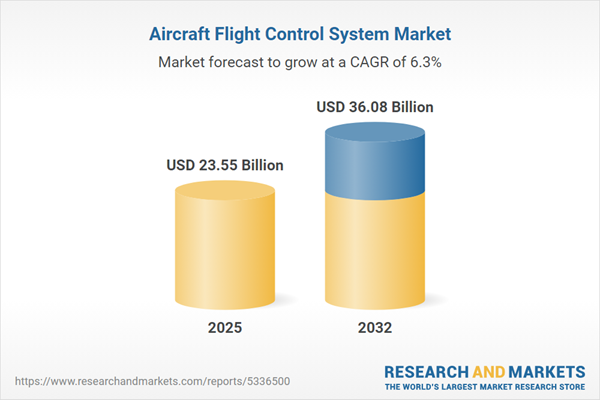Speak directly to the analyst to clarify any post sales queries you may have.
The aircraft flight control system market is undergoing significant transformation as regulatory evolution, digital integration, and the drive for operational efficiency redefine industry priorities. Senior leaders must make informed, risk-aware investment decisions as innovation accelerates.
Market Snapshot: Aircraft Flight Control System Market Overview
The global aircraft flight control system market is expanding in response to rapid adoption of digital technologies by aviation operators modernizing their fleets. Steadfast investment—across both commercial and defense applications—fuels advancement and heightens focus on resilience. Operators seek enhanced responsiveness and data-driven performance as advanced flight control systems become key to meeting new and evolving regulatory obligations. The trend toward modernization, including digital upgrades and innovation initiatives, ensures airlines and defense organizations can maintain continuity and adapt to technology shifts and compliance requirements. These forces sustain market momentum and drive further integration of advanced control solutions.
Scope & Segmentation of the Aircraft Flight Control System Market
- Component Type: Includes firmware, actuators, avionics sensors, flight control computers, control laws, and management software, all vital for robust integration and compliance with stringent safety standards.
- Platform: Covers fixed wing aircraft, rotary wing models, and unmanned aerial vehicles (UAVs), each facing unique engineering and certification requirements that shape integration and operational approaches in both civil and defense sectors.
- Aircraft Type: Serves business jets, commercial fleet operators, and military aircraft, with tailored system solutions to address sector-specific operational, security, and compliance needs.
- Sales Channel: Encompasses aftermarket and original equipment manufacturer (OEM) distribution, which influence technology usage, ongoing maintenance cycles, and the timing of upgrades through the aircraft lifecycle.
- End User: Addresses the operational priorities of full-service carriers, low-cost airlines, military users, and naval forces by supporting mission-specific integration strategies to meet compliance and service objectives.
- Key Regions: Spans the United States, Canada, Brazil, the United Kingdom, Germany, France, Russia, Saudi Arabia, UAE, South Africa, China, India, Japan, and Australia, where regulatory variations and differing rates of technology adoption affect certification processes and go-to-market strategies.
- Key Companies: Leading companies such as Honeywell International Inc., Collins Aerospace Inc., Parker-Hannifin Corporation, Safran SA, Moog Inc., BAE Systems plc, Thales Group, Eaton Corporation plc, Meggitt plc, and General Electric Company are setting industry benchmarks and shaping flight control system evolution.
- Core Technologies & Trends: The sector leverages digital fly-by-wire systems, modular architectures, advanced sensors, adaptive software, machine learning applications, and secure over-the-air updates—enabling predictive maintenance, streamlined fleet oversight, and operational stability.
Key Takeaways for Decision Makers
- Adoption of digital flight control systems allows organizations to adapt to evolving regulations and dynamic operational requirements, positioning them for robust continuity planning and effective risk mitigation.
- Building strategic relationships with core suppliers supports seamless technology integration and alignment with new certification and compliance benchmarks.
- Integration of modular, lightweight systems—especially for UAVs and rotorcraft—delivers adaptability, supporting varied civil and military missions and expanding operational flexibility.
- Deployment of data-driven maintenance approaches increases system reliability, elevates aircraft availability, and improves organizational efficiencies by reducing unscheduled downtime.
- Paired investments in cybersecurity and modular technology architectures ensure system infrastructure can support future advancements while safeguarding critical assets from emerging risks.
- Diversifying suppliers and adopting agile upgrade strategies reduces vulnerability to market volatility and strengthens supply chain stability across the sector.
Impact of New United States Tariffs on Supply Chains
The introduction of new United States tariffs on avionics components has intensified industry focus on proactive supply chain management. Enterprises are reinforcing relationships with existing suppliers, seeking regional production capabilities, and adjusting sourcing practices to maintain operational continuity. Updated procurement strategies are increasingly applied to help counteract tariffs and enhance resilience against regulatory changes.
Aircraft Flight Control System Market Research Methodology & Data Sources
Market insights are grounded in structured interviews with avionics engineers, procurement authorities, and operational managers from both commercial and defense aviation. Data quality is assured through alignment with industry technical standards and the use of reputable trade publications, delivering reliable recommendations to support executive strategic planning.
Why This Report Matters for B2B Executives
- Supports executive decision-making on technology investments and procurement, driving operational compliance and alignment with broader industry transition.
- Clarifies challenges tied to digital transformation, providing actionable guidance as organizations navigate supply chain complexity and set integration goals.
- Connects investment decisions to organizational objectives, strengthening risk-aware planning at enterprise scale.
Conclusion
This analysis equips aerospace stakeholders with actionable frameworks to strengthen resilient planning, sustain operational continuity, and drive proactive adoption of emerging flight control technologies.
Additional Product Information:
- Purchase of this report includes 1 year online access with quarterly updates.
- This report can be updated on request. Please contact our Customer Experience team using the Ask a Question widget on our website.
Table of Contents
3. Executive Summary
4. Market Overview
7. Cumulative Impact of Artificial Intelligence 2025
Companies Mentioned
The companies profiled in this Aircraft Flight Control System market report include:- Honeywell International Inc.
- Collins Aerospace Inc.
- Parker-Hannifin Corporation
- Safran SA
- Moog Inc.
- BAE Systems plc
- Thales Group
- Eaton Corporation plc
- Meggitt plc
- General Electric Company
Table Information
| Report Attribute | Details |
|---|---|
| No. of Pages | 199 |
| Published | October 2025 |
| Forecast Period | 2025 - 2032 |
| Estimated Market Value ( USD | $ 23.55 Billion |
| Forecasted Market Value ( USD | $ 36.08 Billion |
| Compound Annual Growth Rate | 6.2% |
| Regions Covered | Global |
| No. of Companies Mentioned | 11 |









